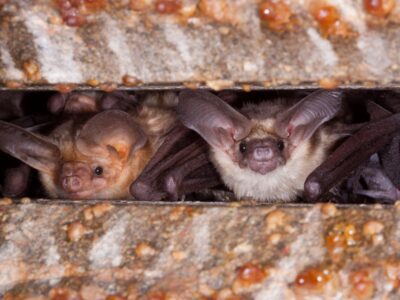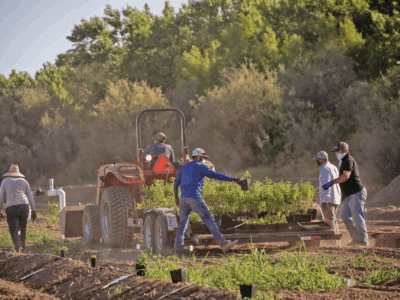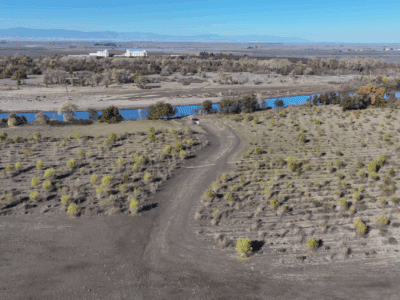The Sacramento River, California’s largest waterway that supplies fresh water to over one-third of the state’s households, businesses, and farmland, once also supported millions of salmon. For thousands of years, the river sustained all four salmon runs—fall, late-fall, winter, and spring. When thriving, these fish were critical to California’s river ecosystems, from their main stems to its slow-water side channels to the Sacramento-San Joaquin Delta on their way to the ocean.
“The fact that salmon spend time in marine environments in the ocean as well as fresh water, there’s this really unique and critical link between the ocean environment and our rivers in the Central Valley,” said River Partners Senior Restoration Science Ecologist Mike Davis.
Today, however, salmon are in serious trouble.
Looked upon as a reflection of overall river health, populations of all runs are significantly down. As an example, according to the California Department of Fish and Wildlife, population trends for Fall-run Chinook salmon in Central Valley rivers have dropped from 872,669 in 2002 to just 79,985 in 2022—a 90% decline over just two decades. While causes of decline are myriad—human-made dams, as well as climate change, drought, and warming water temperatures are a few culprits—hydrologic alteration and habitat loss have major influence.
And this emphasizes the importance of side channels for salmon.
Much more than just a part of the river, side channels are components of the river that add complexity and cover where young salmon can hide from predators, slow-moving water and abundant food supply to grow, and gravel beds where salmon can spawn. And prior to dams and other alterations, braided river channels were the norm, providing salmon with another level of safety and diverse and nutrient-rich habitats. In short, side channels provide everything salmon need to survive—and when they’re not doing well, salmon aren’t doing well.
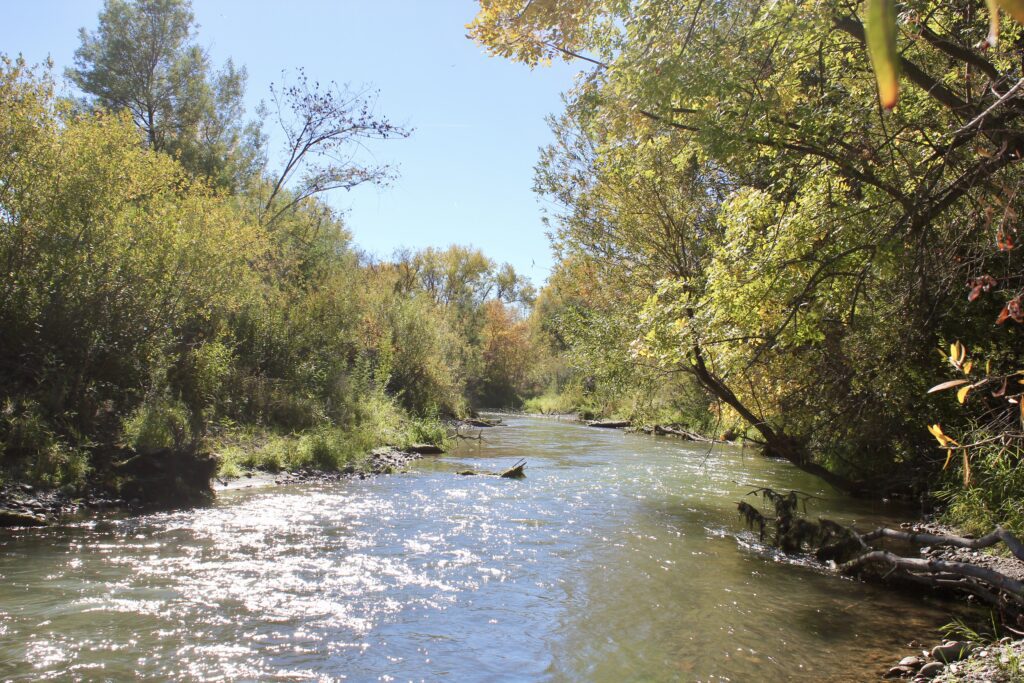
Requiring an expedited, scaled-up investment to restore vital habitat to reverse salmon’s slide toward extinction, River Partners is re-engineering historic side channels and floodplain rearing habitats up and down the Sacramento River. A majority of the side channel efforts River Partners is currently undertaking is being led by River Partners Senior Restoration Science Ecologist Jennifer Rotnem. Partnering with state and federal agencies at eight sites along a 130-mile stretch of the Sacramento River—from Redding in the north to south of Colusa—Rotnem said side channel habitat restoration is a piece of the overall salmon puzzle.
“These projects are part of a larger strategy to increase Chinook salmon and steelhead populations in the Sacramento River,” Rotnem said. “The side channels provide essential rearing habitat with food and cover for juvenile salmonids and act as rest stops along their migration to the Pacific Ocean.”
The work is challenging and tedious. After conducting extensive studies to understand river conditions, and partnering with key agencies to develop engineering plans, the on-the-ground work begins. Artificial barriers to fish passage (like berms and culverts) will be removed and woody debris and boulders will be placed in the side channels, alongside replanted riparian vegetation, to create the proper rearing habitat for juvenile salmon. Straw mulch and seeding of native grasses and forbs will prevent erosion after construction.
It’s a lot of work—but something as vital and precious to our state’s rivers as salmon surely deserves it.

“Salmon are keystone species in the ecosystem,” said John Hannon, Fisheries Biologist for the U.S. Bureau of Reclamation, the originating agency for the Central Valley Project Improvement Act (or CVPIA, Central Valley Project Improvement Act, and important piece of U.S. federal legislation passed in 1992 addressing environmental and wildlife concerns, particularly in the Central Valley). “So, when they aren’t doing well, we know a lot of things aren’t as healthy as they’ve been in the past.”
What Happened?
Historically, the Sacramento River was a dynamic and varied place, providing salmon with what they needed to thrive, including side channels’ slower-moving water and roots and downed branches for the fish to eat, rest, and hide from predators. Infrastructure, agricultural development, and levees cut off the river’s access to floodplains—where salmon could safely eat and grow as they prepared for the next leg of their journey. Rivers that once flowed over vast landscapes and floodplains are now channeled through a maze of farmland and cities. Tiny fry emerging from gravel beds must dodge dams, water diversions, disease, and predators in warming waters depleted of vital nutrients.
“For thousands of years, salmon lived and thrived in an environment to which they were very well adapted, but now with so many challenges and hurdles to overcome, their journey is more difficult than ever,” said Tricia Bratcher, the CVPIA Northern Watershed Supervisor for the Red Bluff office of the U.S. Fish and Wildlife Service, a partner in the side channel restoration projects. “Add the impacts of climate change to the mix and it further exacerbates the challenges, issues, and concerns.”
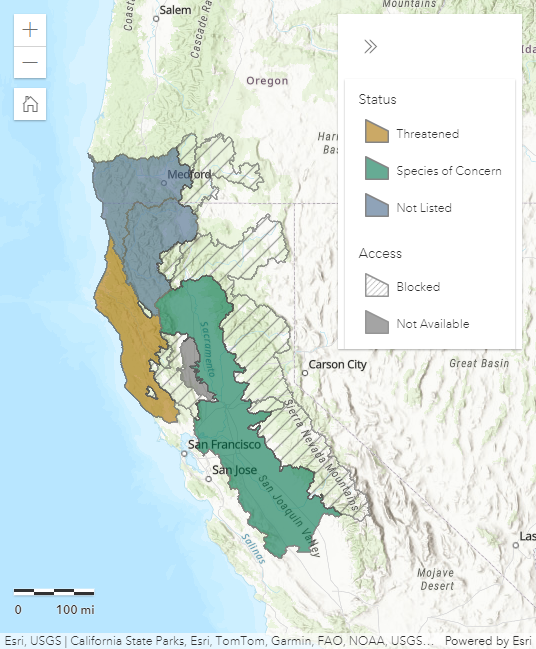
Spring-run Chinook salmon, which migrate upstream from the ocean from late March through September, are particularly vulnerable to climate change and warming water temperatures because dams block them from accessing their historic, high-elevation spawning areas. Broadly speaking, what was once a complicated array of channels weaving in and out of the main channels of the state’s rivers have declined to a whisper here and there.
“All of the changes we’ve made to the Sacramento River over the last 100 years have simplified the river almost in its entire length and cut it off from the flow patterns it used to have,” Davis said. “The side channels are just one strategy to reintroduce some dynamic variable conditions to the river.”
River Partners Associate Director of Restoration Science Michael Rogner emphasized that restoring and enhancing historic side channels is just a part of River Partners’ holistic approach to restoring floodplain rearing habitats along the Sacramento River.
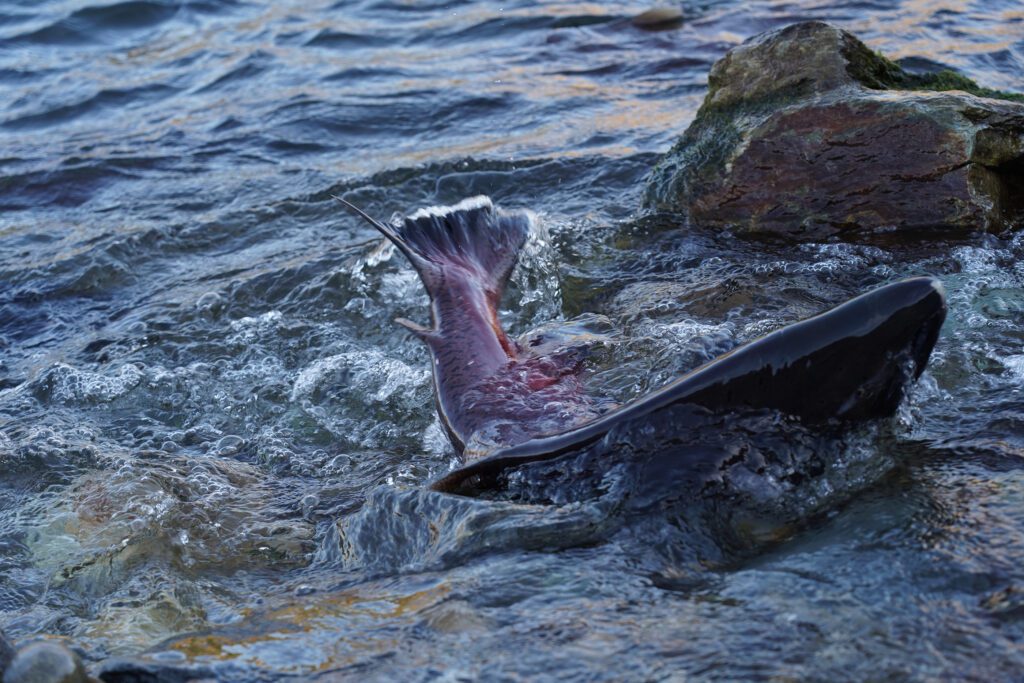
“When we talk about side channel restoration, what we’re really talking about is different ways of connecting the floodplain,” Rogner said. “Perennial side channels are one way, but there’s also ephemeral channels and areas we can open up to flooding and all the different activations we can make that will all benefit salmon. Looking at the big picture, when we ask, ‘Why are side channels good?,’ we’re really asking, ‘Why is floodplain reconnection good?’”
By allowing the floodplains, rivers, and side channels to act more naturally, efforts by River Partners and partners like the U.S. Fish and Wildlife Service, U.S. Bureau of Reclamation, and the Yurok Tribe are helping to give salmon a fighting chance.
It’s important to distinguish between wild, natural fish in the Central Valley and those introduced by fish hatcheries. Davis said that, in many ways, salmon numbers have already collapsed, and abundance of true wild fish is very low.
“I think sometimes in popular discourse, we assume that salmon are still out there—and they are—but they’re artificially propped up by the infusion of hundreds of thousands of hatchery fish every year,” Davis said. “So, when we talk about wild fish, the situation is totally dire.”
Testing Salmon’s Strength and Resilience
The primary need for salmon in the Central Valley is greater habitat connectivity—which is complicated. They require access to varied habitats, access to floodplains on their way out to the ocean, and access to cold water, which was historically provided by the Sierra Nevada foothills. Bringing back historical habitat connectivity is what the side channel floodplain rearing projects River Partners is leading along the Sacramento River can do.
“They provide connectivity from the mainstem of the river to the floodplain,” Davis said. “The two things salmon need most are access to floodplains and access to cold water. They need many things and River Partners is working very hard on a big, important piece.”
Salmon’s strength comes from the diversity of the runs and the large geographic area over which they live.
“This is not an animal that lives in a very small place, it has a huge range, it goes many thousands of miles,” Rogner said. “It needs lots of people working on every different segment of its life history—we’re focused on the rearing habitat part.”
Historically salmon’s stability and ability to thrive happened via the large area in which they lived throughout the Central Valley and all the different streams they had access to. Davis said this is called the “portfolio effect.”

“Not unlike your 401K or your investment portfolio, it’s smart for your account or your species to be invested in a lot of different areas,” he said. “In any given year, bad things are going to happen in one of those accounts, or one of those rivers. But because you have so many different accounts, or so many different rivers, to rely on, the stability of the account, or the population, is protected.”
Davis said that while entire runs have been lost in certain rivers, California hasn’t yet lost an entire run across the Central Valley. So, what happens should a single run completely dry up?
“If we were to lose one, the genetic diversity of that run is lost forever,” Davis said, “and it’s impossible to regain it.”
The ripple effect could be, and in some cases already has been, catastrophic for the many and varied ecosystems a salmon touches—from river and ocean waters to the waterfowl and mammals to the riparian habitats it swims through.
“Where we are with wild salmon is a terrible, terrible place, what we’re facing now is a permanent loss of biodiversity, and this makes it impossible to even imagine a world restored to any resemblance of what it once was,” Rogner said.
The impact of lost salmon would also significantly touch Indigenous people who have relied on the fish for sustenance, gatherings, and cultural identity.
“That has the potential to rip more threads out of a culture that’s many thousands of years old,” Rogner warns.
Indigenous Importance
William Bowers, a proud member of the Yurok Tribe, grew up in Ashland, Oregon, and has had an intimate connection with rivers, particularly the Klamath River, his entire life.
“I started fishing the Klamath when I was 3 years old,” Bowers said. “Being on the river and fishing have always given me so much joy.”
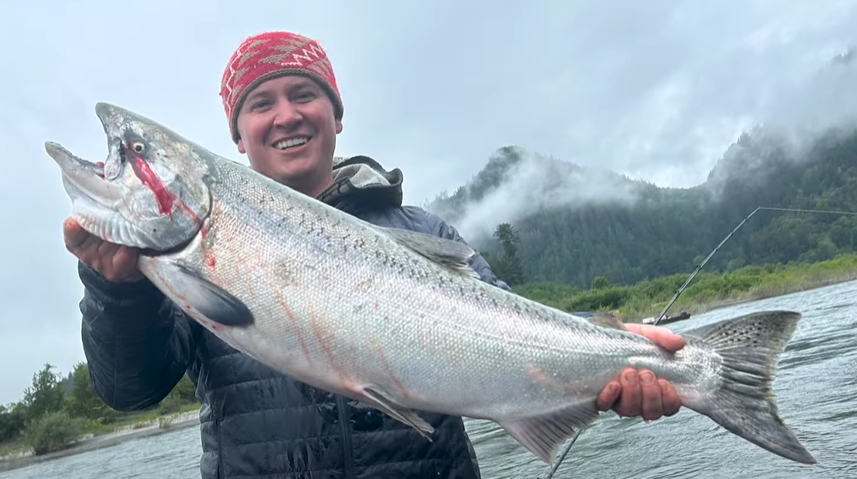
As a Project Manager for the Yurok Tribe Construction Corporation, he has a hand in helping enhance, restore, and rebuild side channels and fish habitats in California rivers, like the Sacramento. Implementing construction plans, grading, excavating, and enhancing the channels provides Bowers with a deep sense of pride.
“My elders, my grandma, they always taught me to take care of the land, because for thousands of years the land has taken care of us. We lived off salmon and steelhead and eels,” Bowers said. “It’s important to keep the streams healthy. When stream ecosystems are fully functioning, it benefits salmon and just about every other native species. This holistic approach is one of our traditional values. It’s important to try to do whatever you can because every little thing affects something.”
While the river environment has generations-deep meaning for Bowers, he also has a very personal connection to it. In 2016, Bowers was working for the Yurok Watershed Department in Klamath, Calif., when an unspeakable tragedy struck his family. Trying to make sense of what happened, he did what felt natural.
“I spent everyday fishing on the Klamath River. And when I was so sad and wondering ‘Why?,’ the river helped me. It helped me accept what happened,” he said. “Honestly, being on the river was the only thing that made me quit thinking about what happened. I was so grateful to be on a river. Being in that environment, catching fish, it brings me so much joy—it means so much to me.”
For the Yurok, and other Indigenous people throughout the state and along every California waterway, the cultural importance of salmon cannot be understated.
“It’s healthy food, we live off them. When there’s a lot of fish, there’s a light through the community where everyone’s happy. It’s because that’s what’s in our DNA, it’s beneficial for all of us,” he said. “And when we don’t have salmon, we have to eat something else that might not be as healthy. And that impacts us, people aren’t as happy, you get depressed. If there’s no fish, you don’t get that same feeling as when you’re catching fish and eating healthily and doing what we were taught to do, what was handed down for generations.
“We were raised this way and so when you’re not able to do something you were raised to do, then what are you going to do?”
“An Important Part of the Problem-Solving”
The footprint for River Partners’ side channel restoration along the Sacramento River is immense. Davis said that through the combination of acreage and geographic coverage, River Partners’ work touches a meaningful number of fish across the whole freshwater lifecycle of salmon.
“The scale of our work is ecologically relevant and has potential to affect recovery at a level that many programs and projects cannot,” he said.
And it’s just one part of our overall strategy to restore floodplain rearing habitats for salmon. The work entails understanding what salmon require along their long and treacherous journey.
“When a young salmon is coming down the river, it’s looking for a spot that’s a bit shallower, a bit slower moving, with a lot of places to hide, and with a lot of bugs in it they can eat,” Davis said. “Side channels or floodplain habitat are much shallower than the main stem of the river and historically has had more habitat complexity, with more downed trees and more branches and vegetation.”
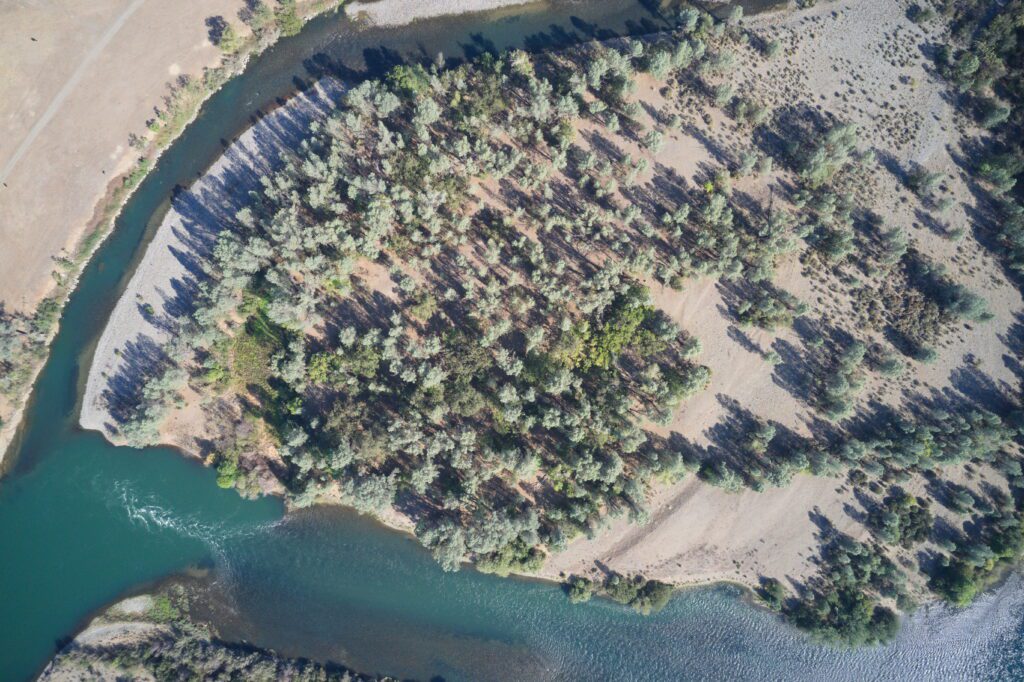
In restoring these types of habitats along the Sacramento River, River Partners is using science to inform our plans and our project partners are helping to implement them, grinding earth, moving branches and limbs, and returning these areas back to the salmon.
Brett Harvey from the California Department of Water Resources said that if the state’s restored side channels lead to a marked increase in Chinook salmon populations, it would show that strides are being made toward achieving resilient and sustainable populations by replacing some of the habitat lost due to dams and flow alterations.
“It would also validate the models we use to guide restoration planning and lend confidence in future restoration efforts,” Harvey added. “An increased abundance of salmon in California is not just important environmentally, but also for communities that find salmon are economically or culturally important.”
“Working with the Yurok and other folks, we’re providing a blueprint for how you can really scale these things up. And there’s no solution without scaling it up,” Rogner said. “An important part of the problem solving is figuring out how to get there in the first place.”
Funding from multiple sources, including the California Department of Water Resources, CVPIA, National Oceanic and Atmospheric Association (NOAA), and Central Valley Tributaries Program, help make these side channel restoration projects possible.
“Our partners are critical. River Partners is an advocate for protected species like Central Valley chinook salmon and we rely on their on-the-ground work to make habitat restoration projects like this a reality,” said Ruth Goodfield, Marine Habitat Resource Specialist with the NOAA Restoration Center. “River Partners has built trust on all sides, from funding agencies like ours to permitting agencies and the public.”
Success can look different to different people, the broadest being more naturally occurring salmon in the Sacramento River and eliminating reliance on fish hatcheries. Rogner and Davis go deeper.
“In the simplest terms, when you walk out to the river and you see baby salmon swimming around in these side channels, in what three months ago was a dry field of weeds and is now a channel with a little fish hiding behind the logs, that’s a good sign,” Rogner said. “When you see salmon spawning, feeding, and swimming, that’s a symbol of what a healthy river could look like.”
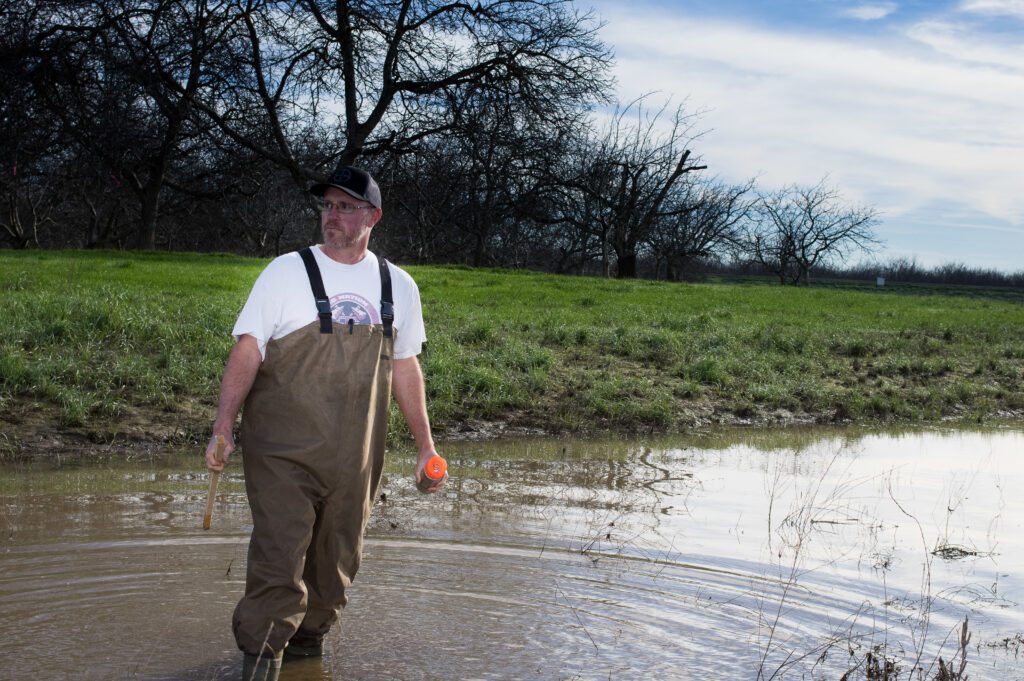
“I think success means drawing more people into this area of work,” Davis said. “We’re not yet working at the scale that’s required, so if we can grow our partnerships with Tribes and others to do more floodplain restoration, I think that’s a benchmark of success to me.”
Meanwhile, as he works to restore side channels and protect the salmon population, Bowers feels a deep kinship as he places his hands in the soil, walks past vegetation, and touches the river waters his ancestors have for time immemorial.
“I look at my life and I’m able to give back. We have a whole crew of people helping to take care of our land and doing restoration work,” Bowers said. “As a Yurok Tribal member, it’s just so awesome.”


